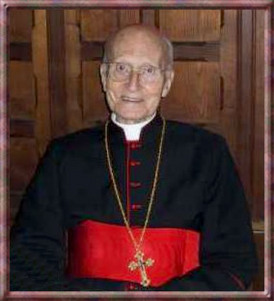 Paul Augustin Cardinal Mayer, OSB, died today just shy of his 99th birthday. He was the Church's eldest Prince.
Paul Augustin Cardinal Mayer, OSB, died today just shy of his 99th birthday. He was the Church's eldest Prince.Holy See: April 2010 Archives
 Paul Augustin Cardinal Mayer, OSB, died today just shy of his 99th birthday. He was the Church's eldest Prince.
Paul Augustin Cardinal Mayer, OSB, died today just shy of his 99th birthday. He was the Church's eldest Prince.I don't typically post the Holy Father's funeral addresses for cardinals here because they'd be too many. But I think this is one is an exceptional circumstance with the death of His Eminence, Tomas Cardinal Spidlik who was laid to rest today. Emphasis added for important points, obviously.
May Cardinal Spidlik's memory be eternal!
Among the last words spoken by the mourned Cardinal Spidlik were these: "I have looked for the face of Jesus during my whole life, and now I am happy and at peace because I am about to see it." This wonderful thought -- so simple, almost childlike in its expression, and yet so profound and true -- refers us immediately to the prayer of Jesus, which resounded a moment ago in the Gospel: "Father, I desire that they also, whom thou hast given me, may be with me where I am, to behold my glory which thou hast given me in thy love for me before the foundation of the world" (John 17:24).
It is beautiful and consoling to meditate on this
correspondence between man's desire, who aspired to see the Lord's face, and
Jesus' own desire. In reality, that of Christ is much more than an aspiration:
It is a will. Jesus says to the Father: "I desire that they also ... may
be where I am." And it is precisely here, in this will, where we find the
"rock," the solid foundation to believe and to hope. The will of
Jesus in fact coincides with that of God the Father, and with the work of the
Holy Spirit it constitutes for man a sort of sure "embrace," strong
and gentle, which leads him to eternal life.

What an immense gift to hear this will of God from his own mouth! I think that the great men of faith live immersed in this grace, they have the gift to perceive this truth with particular force, and so can also go through harsh trials, such as those that Father Tomas Spidlik went through, without losing confidence, and keeping, on the contrary, a lively sense of humor, which is certainly a sign of intelligence but also of interior liberty. Under this profile, evident was the likeness between our mourned cardinal and the Venerable John Paul II: both were given to ingenious joking and jokes, even though having had as youths difficult personal circumstances, similar in some aspects. Providence made them meet and collaborate for the good of the Church, especially so that she would learn to breathe fully "with her two lungs," as the Slav Pope liked to say.
This liberty and presence of spirit has its objective foundation in the Resurrection of Christ. I want to underline it because we are in the Easter liturgical season and because it is suggested by the first and second biblical readings of this celebration. In his first preaching, on the day of Pentecost, St. Peter, full of the Holy Spirit, proclaims the realization in Jesus Christ of Psalm 16.
It is wonderful to see how the Holy Spirit reveals to the Apostles all the beauty of those words in the full interior light of the Resurrection: "I saw the Lord always before me, for he is at my right hand that I may not be shaken; therefore my heart was glad, and my tongue rejoiced; moreover my flesh will dwell in hope" (Acts 2:25-26; cf Psalm 16/15:8-9). This prayer finds superabundant fulfillment when Christ, the Holy One of God, is not abandoned in hell. He in the first place has known "ways of life" and has been filled with joy with the presence of the Father (cf Acts 2:27-28; Psalm 16/15:11).
The hope and joy of the Risen Jesus are also the hope and joy of his friends, thanks to the action of the Holy Spirit. Father Spidlik demonstrated it habitually with his way of living, and this witness of his was ever more eloquent with the passing of the years because, despite his advanced age and the inevitable infirmities, his spirit remained fresh and youthful. What is this if not friendship with the Risen Lord?
In the second reading, St. Peter blesses God that "by his great mercy we have been born anew to a living hope through the resurrection of Jesus Christ from the dead." And he adds: "In this you rejoice, though now for a little while you may have to suffer various trials" (1 Peter 1:3.6). Here, too, is seen clearly how hope and joy are theological realities that emanate from the mystery of the Resurrection of Christ and from the gift of his Spirit. We could say that the Holy Spirit takes them from the heart of the Risen Christ and infuses them in the heart of his friends.
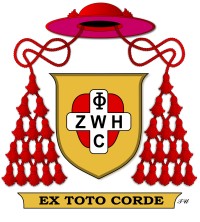
I introduced on purpose the image of the "heart," because, as many of you know, Father Spidlik chose it as the motto of his cardinal's coat of arms: "Ex toto corde," "with all the heart." This expression is found in the Book of Deuteronomy, within the first and fundamental commandment of the law, there where Moses says to the people: "Hear, O Israel: The Lord our God is one Lord; and you shall love the Lord your God with all your heart, and with all your soul, and with all your might" (Deuteronomy 6:4-5). "With all the heart -- ex toto corde" refers hence to the way with which Israel must love its God. Jesus confirms the primacy of this commandment, which he combines with that of love of neighbor, affirming that the latter is "similar" to the first and that from both the whole law and the prophets depend (cf Matthew 22:37-39). Choosing this motto, our venerated brother placed, so to speak, his life within the commandment of love, he inscribed it wholly in the primacy of God and of charity.
There is another aspect, a further meaning of the expression "ex toto corde," that surely Father Spidlik had present and attempted to manifest with his motto. Always starting from the Biblical root, the symbol of the heart represents in Eastern spirituality the seat of prayer, of the meeting between man and God, but also with other men and with the cosmos. And here we must remember that in Cardinal Spidlik's standard, the heart that the coat of arms shows contains a cross in whose arms intersect the words "phos" and "zoe" -- "light" and "life" -- which are names of God. Hence, the man who fully receives, "ex toto corde," the love of God, receives light and life, and becomes in turn light and life in humanity and in the universe.
But who is this man? Who is this "heart" of the
world, if not Jesus Christ? He is the Light and life, for in Him "the
whole fullness of deity dwells bodily" (Colossians 2:0). And I wish to
recall here that our deceased brother was a member of the Society of Jesus,
that is, a spiritual son of St. Ignatius who put in the center of faith and
spirituality the contemplation of God in the mystery of Christ.
In this symbol of the heart East and West meet, not in a devotional but in a profoundly Christological sense, as other Jesuit theologians of the last century revealed. And Christ, central figure of Revelation, is also the formal principle of Christian art, a realm that had in Father Spidlik a great teacher, inspirer of ideas and of expressive projects, which found an important synthesis in the Redemptoris Mater chapel of the Apostolic Palace.
I would like to conclude returning to the theme of the Resurrection, quoting a text much loved by cardinal Spidlik, a fragment of the Hymns on the Resurrection of St. Ephrem the Syrian:
"From on High He descended as Lord,
From the womb he issued as a slave,
Death knelt before Him in Sheol,
And life adored Him in his resurrection.
"Blessed is his victory!" (No. 1:8).
May the Virgin Mother of God accompany the soul of our venerated brother in the embrace of the Most Holy Trinity, where "with all the heart" he will eternally praise his infinite Love. Amen.
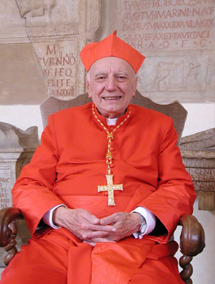 The staff of the Centro Aletti with faith in the life-giving power of the Lord's Resurrection announced the death of Tomáš Cardinal Špidlík Friday, 16 April 2010 at 9 pm.
The staff of the Centro Aletti with faith in the life-giving power of the Lord's Resurrection announced the death of Tomáš Cardinal Špidlík Friday, 16 April 2010 at 9 pm.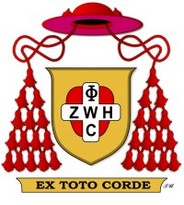
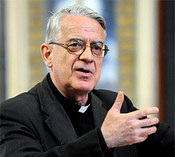
This past Friday (April 9) Jesuit Father Federico Lombardi, director of the Vatican press office, spoke about the sexual abuse of minors. Remembering that Father Lombardi is only the press director for the Vatican and not someone who sets policy, this statement fine. It evokes some questions and it opens conversation, in my opinion. I think it is necessary to read the address in its entirety because there are a number of points made therein that were not mentioned --no surprise-- in the secular media. This is his statement as published by Vatican Radio.
The debate concerning sexual abuse, and not only that committed by the
clergy, continues with news items and comments of various kinds. How can we
sail through these stormy waters while maintaining a secure course and
responding to the evangelical motto 'Duc in altum' -- Put out into the deep?
In the first place, by continuing to seek truth, and peace for the victims. One of the most striking things is that today so many inner wounds are coming to light, wounds that also date to many years (sometimes decades) ago, but evidently still open. Many victims do not seek financial compensation but inner assistance, a judgment on their painful individual experiences. There is something that we have yet to fully understand; perhaps we need a more profound experience of events that have had such a negative impact on the lives of individuals, of the Church and of society. One example of this, at the collective level, is the hatred and violence of conflicts between peoples which are, as we see, so difficult to overcome in true reconciliation. Abuse opens wounds at a deep inner level. For this reason, certain episcopates were right when they courageously resumed developing ways and places in which victims could express themselves freely, listening to them without taking it for granted that the problem had already been faced and overcome by the workshops established sometime ago. For this reason also, other episcopates and individual bishops were right to intervene paternally, showing spiritual, liturgical and human concern for victims. It seems certain that the number of new accusations of abuse is falling, as is happening in the United States, but for many people the road to profound healing is only now beginning, and for others it has yet to start. In the context of this concern for victims, the Pope has written of his readiness to hold new meetings with then, thus sharing in the journey of the entire ecclesial community. But this journey, in order to achieve profound effects, must take place in respect for people and the search for peace.
Alongside concern for victims we must continue to implement, decisively and truthfully, the correct procedures for the canonical judgment of the guilty, and for collaborating with the civil authorities in matters concerning their judicial and penal competencies, taking the specific norms and situations of the various countries into account. Only in this way can we hope effectively to rebuild a climate of justice and complete trust in the ecclesiastical institution. It has happened that a number of leaders of communities and institutions, through inexperience or unpreparedness, have not had a ready understanding of the protocols and criteria for intervention which could have helped them intervene decisively even when this was very difficult or painful for them, also because they were often surprised by the accusations. But, while civil law intervenes through general norms, canon law must take account of the specific moral gravity of an abuse of the trust placed in persons who hold positions of responsibility within the ecclesial community, and of the flagrant contradiction with the conduct they should show. In this sense, transparency and rigour are urgent requirements if the Church is to bear witness to wise and just government.
The formation and selection of candidates for the priesthood, and more generally of the staff of educational and pastoral institutions, is the basis for an effective prevention of the risk of future abuses. Achieving a healthy maturity of the personality, also from a sexual point of view, has always been a difficult challenge, but today it is particularly so, although the best psychological and medical knowledge is of great help in spiritual and moral formation. It has been observed that the greatest frequency of abuses coincided with the most intense period of the 'sexual revolution' of past decades. Formation must take account of this context and of the more general context of secularisation. In the final analysis, this means rediscovering and reaffirming the sense and importance of sexuality, chastity and emotional relationships in today's world, and doing so in concrete, not just verbal or abstract, terms. What a source of disorder and suffering their violation or undervaluation can be! As the Pope observed in his Letter to Irish Catholics, a Christian priestly life today can respond to the requirements of its vocation only by truly nourishing itself at the wellspring of faith and friendship with Christ.
People who love truth and the objective evaluation of problems will know where to seek and find information for a more overall comprehension of the problem of paedophilia and the sexual abuse of minors in our time, in different countries, understanding its range and pervasiveness. Thus they will be able to achieve a better understanding of the degree to which the Catholic Church shares problems that are not only her own, to what extent they have particular gravity for her and require specific interventions, and, finally, the extent to which the experience the Church is going through in this field may also be useful for other institutions or for society as a whole. In this context, we truly feel that the communications media have not yet worked sufficiently, especially in countries in which the Church has a stronger presence and in which she is more easily subject to criticism. Yet, documents such as the national U.S. report on the mistreatment of children deserve to be better known in order to understand what fields require urgent social intervention, and the proportions of the problem. In the U.S.A. in 2008 alone, 62,000 people were identified as having committed acts of abuse against minors, while the proportion of Catholic priests was so small as not to be taken into consideration as a group.
The protection of minors and young people is, then, an immense and unlimited field, which goes well beyond the specific problem concerning certain members of the clergy. People who sensitively, generously and attentively dedicate their efforts to this problem deserve gratitude, respect and encouragement from everyone, especially from the ecclesial and civil authorities. Theirs is an essential contribution for the serenity and credibility of the education and formation of young people, both inside and outside the Church. The Pope rightly expressed words of great appreciation for them in his Letter to Irish Catholics, though naturally with a view to a vaster horizon.
Finally, Pope Benedict XVI, a coherent guide along the path of rigour and truth, merits all respect and support, testimony of which is reaching him from all parts of the Church. He is a pastor well capable of facing -- with great rectitude and confidence -- this difficult time in which there is no lack of criticism and unfounded insinuations. It must be said that he is a Pope who has spoken a lot about the Truth of God and about respect for truth; and he has become a credible witness of this. We accompany him, learning from him the constancy necessary to grow in truth and transparency, continuing to open our horizons to the serious problems of the world and responding patiently to the slow and gradual release of partial or presumed 'revelations' which seek to undermine his credibility, and that of other institutions or individuals of the Church.
This patient and solid love of truth
is necessary, in the Church, in the society in which we live, in communicating
and in writing, if we wish to serve rather than confuse our fellow men and
women.

